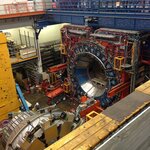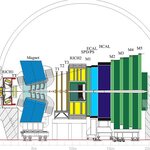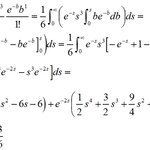Physics

Like HAL 9000 in the wonderful movie "2001 - the space odyssey", the CDF detector is being disassembled piece by piece, losing its functionality bit by bit, and turning from one of the most complex electronics systems ever built into a pile of junk in the course of a long, slow process. The central part of the detector has been transported out of the collision hall on rails, into the assembly hall, which is now serving the opposite purpose. If you ever visited Fermilab, the assembly hall is inside the big orange building you drove by as you got to the Wilson Hall from the east entrance…
What can be logically prior, what must be assumed, what is the metaphysically necessary apriori starting point? Here I present the one necessary before I can focus on understanding time in order to derive Einstein locality. These are crucial steps in rendering quantum mechanics naturally expected,[1,2] which is the only interesting aim, because Einstein’s relativity alone easily emerges from classical substrates[4], while the apparent non-locality of quantum mechanics cannot; well, except via brain-in-vat/The Matrix scenarios, but that just underlines how quantum mechanics indeed relates…

Jacques Distler is a Professor of Physics at the University of Texas at Austin, and a distinguished theorist, as well as a physics blogger. Along with experimentalist Gordon Watts (who covered $250) he took my $1000 bet that the LHC would not discover new physics in its first 10/fb of proton-proton collision data. I discussed my take on the bet in a previous post; here Jacques explains his point of view, why he took the bet, and what he thinks of the present situation with new physics searches at the high-energy frontier. The article below has appeared today at Distler's blog, and I reproduce…
In short particles with more mass lead to beams with more energy. More massive particles reach these energies
with much smaller machines. Interesting and fundamental physics
would be possible with a muon collider, of 6.3 km circumference and
neutrino factory which would be far less expensive than a 50 km
linear electron accelerator. As we learned from the Superconducting Supercollider less expensive is good, more expensive is less likely to be built
Image of one of the buildings for the superconducting supercollider credit wikimedia.
Scientific minds like equations. …

In September 2006 I was in Ponta Delgada, the main town of the island of San Miguel in the Azores, for a physics conference where I was presenting results of the CDF experiment.
I remember listening to a very nice talk by Guido Martinelli, who was discussing the status of flavour physics, and getting rather depressed at the view of a very consistent picture of agreement between B physics observables and Standard Model predictions. This came at a moment when the CDF experiment had been probing the high-energy frontier with very detailed measurements, none of which appeared to show even the…

A thick paper by the ATLAS collaboration has been published by the Cornell Arxiv today. It is going to become a reference to all ATLAS analyses searching for new phenomena at high energy, or studies of boosted top quarks or vector bosons; and a good example of the new techniques that make sense of the energy distribution inside high-momentum jets.
The paper is very technical, as it should, and only readers familiar with jet reconstruction techniques may benefit from a careful look at it. However, here I believe it is interesting to summarize what the whole thing is about, in as simple terms…

I have had my fair share of confusion and straightening out over the years, mostly something I accept as a challenge (life wouldn't be fun without challenges...)
But it struck me as strange when I finally found out that two things they taught me when I took the undergrad 'intro to modern physics' course are not true. And I had spent a long time horribly confused by these two myths before I finally came to an understanding.
The first 'fact' that just ain't so is that the photoelectric effect requires that electromagnetic radiation be quantized for its explanation. The photoelectric effect…

LHCb, one of the two "satellite" experiments at the Large Hadron Collider, is a detector focusing on the production of B hadrons in proton-proton collisions. It does so by looking at only one side of the collision point, which is showered by the majority of the debris produced when one very-high-momentum parton inside the proton coming from the other side hits a moderately or low-momentum parton in the other proton coming from the LHCb side of the collision region. A sketch of the LHCb layout is shown below.
(In the picture you can see the various detector elements seen from a side. The…

The all electron
full-potential linearized augmented plane wave plus local orbitals method was
utilized to study the structural properties of ZnO (0001) ultra-thin films
(nanosheets). From the calculations, it was observed that in the presence of
oxygen vacancies at the Zn-terminated (0001) surface of the ZnO nanosheets, the
structural phase transformation from the graphite-like structure to wurtzite
lattice occur even if the thickness of the ZnO nanosheet along the c-axis is
less than or equal to 4 atomic graphite-like layers [J. Appl. Phys. 113, 014304 (2013)].
Most of the…

The problem of classifying elements of a data set as belonging to one class or another, depending on their characteristics, is a very, very well-studied one, and one which is particularly important in particle physics.
Imagine, for instance, that you collect events with four high-transverse-momentum leptons (electrons or muons) with the ATLAS or CMS detector, and you wish to sort out which of these fit better to the hypothesis of being originated by Higgs boson decay into two Z bosons (with each Z boson in turn producing a lepton pair) rather than to the alternative hypothesis of being due…